Planning and operating a construction site is a complex process. It requires precise preparation, prudent supervision and quality execution from both clients and construction companies. In terms of ecological sustainability, this involves issues such as the use of materials, the conservation of resources, transport, the avoidance of pollutants and the preservation of biodiversity. Equally relevant, however, are aspects relating to social responsibility on construction sites. Here, among other things, the safety of all those involved in construction and the use of preventive health protection measures are highly relevant.
At the same time, a successful, smooth construction process often stands or falls with the acceptance of the local public. Information, involvement and dialogue are crucial here. This is precisely where the DGNB System for Sustainable Construction Sites comes in. As a planning and management tool, the certification helps with quality assurance and risk minimisation on the construction site.
DGNB System for Special Civil Engineering
Do you have a project that falls into the area of special civil engineering? The DGNB has developed a variant of the system specifically for this purpose.
Learn more
The DGNB System for Construction Sites illustrates the life-cycle oriented approach of the DGNB and consequently starts with the planning of the construction site.
The target groups of the certification, which is equally applicable to building construction and civil engineering projects, are primarily building owners, municipalities and construction companies.
... for building owners
Building owners can submit their project for certification. The advantages are manifold:
- Smoother construction process
- Positive image of the construction site (safe, clean, sustainable)
- Additional quality assurance of the construction work
- Risk minimisation through precautionary concepts
- Demonstrable sustainability
- Positive impact on planned certifications of the district or individual buildings at the site
... for building contractors
Construction companies can submit their concept for sustainable building sites and have it evaluated and awarded as part of a basic certification. For all subsequent construction sites, this certification applies as the basis for the project-specific evaluation. You benefit in several ways:
- Basic certificate as a unique selling point compared to competitors
- Employee safety
- Systematically optimising existing processes
- Greater attractiveness as an employer for (new) employees
... for municipalities
Municipalities have the option of making DGNB Certification a requirement and thus contributing to quality assurance at the municipal level:
- Contribution to the achievement of municipal sustainability goals
- Higher acceptance of the construction site by the local public
- Smoother construction process
The criteria - What makes a sustainable construction site?
The DGNB System does not assess individual measures, but the overall performance based on criteria and associated indicators. For construction sites, a total of five criteria are taken into account. These were designed with practical relevance to the processes on construction sites and simultaneously address the five topic areas of ecology, economy, socio-cultural and functional aspects, technology and processes. Some of the criteria must be fulfilled as a minimum requirement.
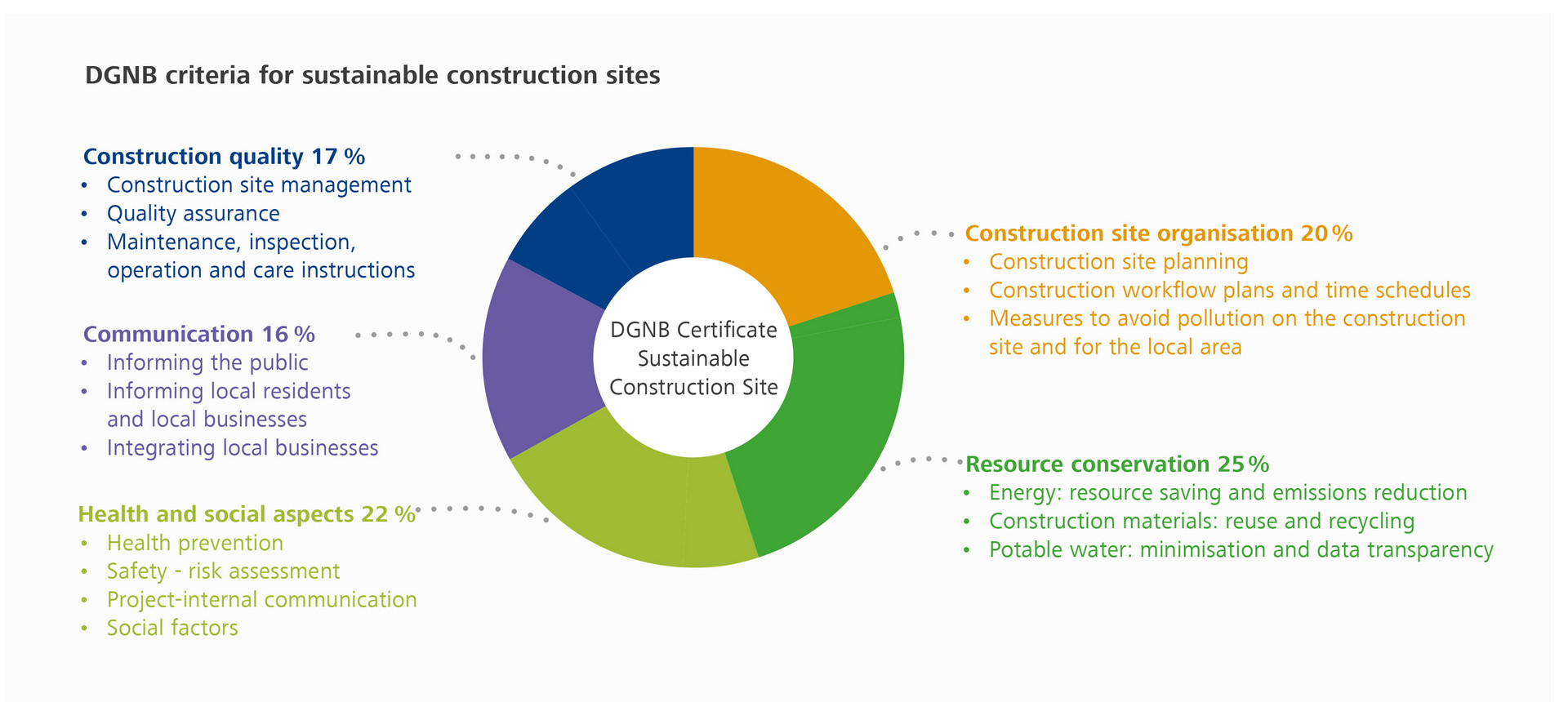
The criteria simultaneously address the five topic areas of ecology, economy, socio-cultural and functional aspects, technology and processes and thus guarantee a holistic sustainable assessment.
Note: The system is currently in the pilot phase. The individual criteria can be found below in the corresponding tabs for download. The basics of the system can be found here: Download basic structure of the system (in German)
The aim of the criterion is to ensure a smooth and safe construction process in the procurement and construction phases through a well-organised construction site. Furthermore, it is important to minimise the impact on the environment and the consumption of resources during construction, to protect the health of all those involved in construction and to promote social acceptance of the construction project through comprehensive communication with the neighbourhood.
The criterion defines essential specifications for construction site planning and its updating across the various construction phases. Schedules and timetables are required, as well as a health and safety plan. In addition, there are measures to prevent pollution of the local environment. This involves concepts for a low-noise, low-dust and low-waste construction site, soil and groundwater protection, as well as logistics oriented towards the environment and residents.
The criterion of construction site organisation is a minimum requirement for a sustainable construction site.
In order to maintain a high value of resources in terms of the circular economy, it is important to create the greatest possible transparency with regard to the selected processes, recycling and disposal routes for the masses produced during construction.
These are to be optimised accordingly through maximum reuse and material recycling. Furthermore, the goal is to sensitise all persons involved in the construction process with regard to actively influencing these processing, recovery and disposal paths.
One aspect of the criterion relates to saving resources and reducing emissions in relation to the energy used. In order to promote climate action, the use of renewable energy is evaluated positively, as is the use of environmentally friendly means of transport. The reuse and recycling of building materials is also in focus, e.g. by actively influencing the recycling and disposal routes. In addition, water consumption is addressed as part of the certification.
An important role is also played by the protection of those involved in construction. Social concerns are to be ensured through preventive health measures, information for further education and training of employees.
With a view to preventive health care, the focus is not only on general medical precautions but also on measures in the event of a special occasion (example: pandemics). A work and safety plan for the main construction trades and a risk assessment by the contracted companies are further indicators. Internal project communication, e.g. with regard to multilingualism, is also addressed. In addition, there are aspects such as job quality or the safeguarding of social benefits for all those involved.
Public acceptance of construction projects is a central aspect. This involves proactively informing people before and during construction measures and being available as a contact person.
Among other things, special importance is attached to the appearance of the construction site for the public. A positive evaluation is made when a digital information platform is provided. Such an approach prevents conflicts and increases the willingness of local stakeholders to cooperate.
In order to realise planning goals and to meet the requirements with regard to the proper use of construction products as well as the aspects of construction supervision and coordination, appropriate quality assurance and meaningful documentation are essential.
Here, for example, a plan administration management, an interface coordination or an improvement management are positively evaluated. The focus is on quality assurance of the construction products used as well as detailed topics such as mould prevention.
The certification process
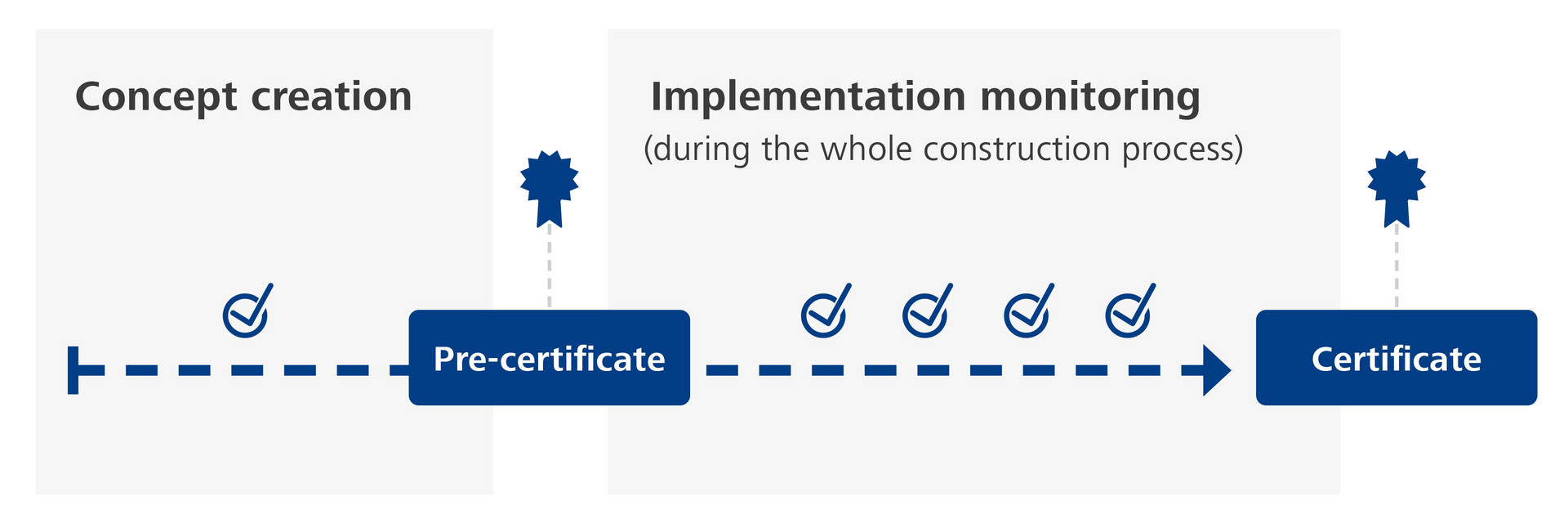
The process of certification runs from the planning of the construction site to its completion. The concept serves as the basis for the evaluation and the award of the preliminary certificate. In order to verify sustainability throughout the entire construction phase, evidence must be submitted at regular intervals during the construction phase. The intervals between inspections depend on the duration and scope of the construction site. Verification must be submitted on specified inspection dates in accordance with the corresponding construction progress. The applicant receives the final DGNB Certificate after successful completion of the construction site.
If a basic certification is sought for construction companies, all documents which can be inspected in advance are submitted. A fixed evaluation of this is then set as the basis for the certification. The DGNB Certificate is awarded following inspection of the documents and once the first projects are defined. For all subsequent projects, only the project-specific documents then need to be submitted. The implementation of the planned measures is then also verified at regular intervals.
If, in addition to the construction site, a certification of the new building is also planned, then the construction site certification provides some benefits. Since in terms of process quality and the construction quality the criteria are identical to the DGNB System for New Construction of Buildings, the evidence to document the construction of the building does not need to be resubmitted.
The evaluation in the DGNB System for Construction Sites is divided into minimum requirements and variable measures.
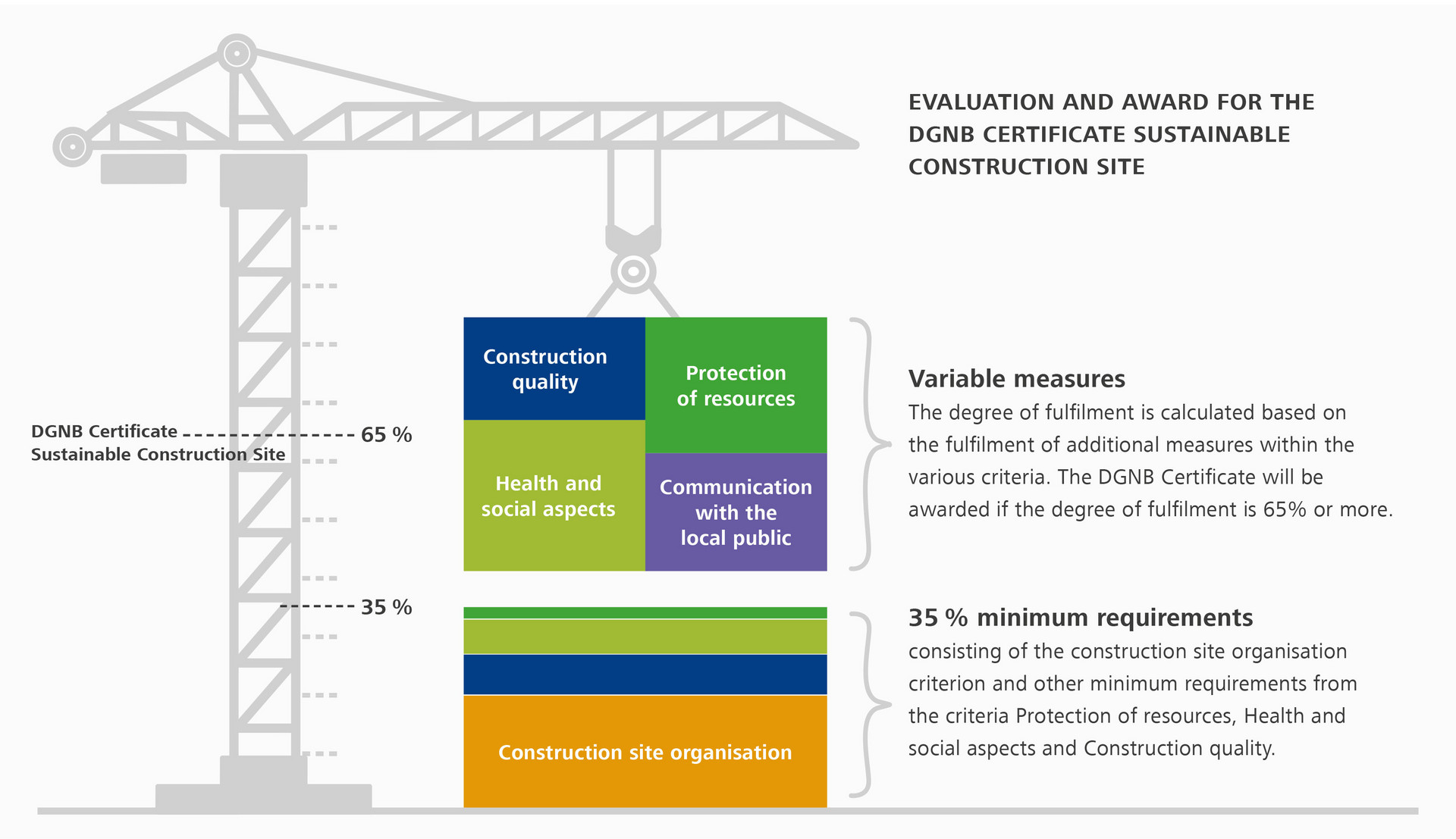
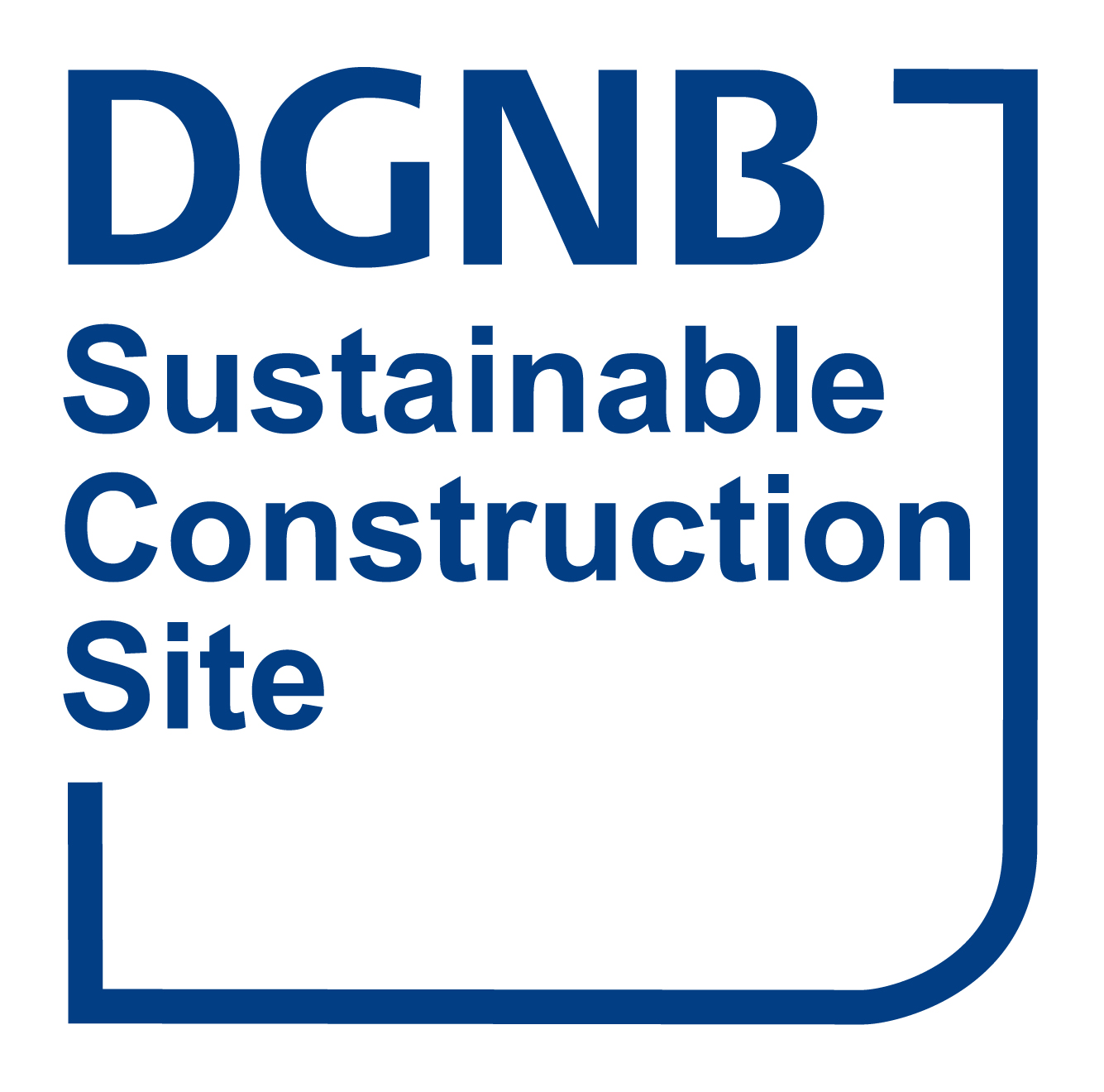
The minimum requirements include 20 indicators that must be fulfilled. By fulfilling them, 35 percent of the maximum possible points are already achieved.
Further points can be achieved through variable measures. The number of points to be achieved in each of the criteria is not decisive. The "DGNB Sustainable Construction Site" award is granted in case of a degree of fulfilment of 65 percent or more. However, the decisive factor for receiving and maintaining the award for the duration of the construction project is the verification of the construction site. Failure to provide proof or incomplete proof will result in the withdrawal of the award.
The system is applied to initial projects as part of the pilot phase and its suitability is being tested. Interested parties have the opportunity to actively participate with their projects.
The DGNB System for Construction Sites is designed to be cross-use and cross-system, and can therefore be used for building site projects of all kinds. Construction sites are understood to mean all work that takes place during the construction, repair and/or modification of building structures. All works also include preparatory and final works of construction sites.
The application is made within the scope of the initial application on request by e-mail. Please feel free to contact us. We will send you the necessary documents for registration as well as for submission.
Within the scope of the pilot phase, the submission of the documents for certification is carried out by a person commissioned by the building owner or, in the case of basic certification, by the construction company, who is not commissioned with the construction management. It is recommended, for example, that a DGNB auditor, consultant or health and safety coordinator be commissioned. The separate commissioning of a sustainability manager also makes sense and is recommended.
The evidence is submitted digitally with the help of the DGNB Construction Site Tool. This is also included in the documents that we send you as part of the registration process.
The certification fees differ depending on the gross floor area and are defined as follows as part of the pilot phase:
| DGNB members* | Non-members* | |
|---|---|---|
| Registration fee | 1000 € | 2500 € |
| Gross floor area in m² | DGNB members* | Non-members* |
|---|---|---|
| < 2,500 | 1400 € | 2400 € |
| > 2,500 - 10,000 | 2000 € | 3300 € |
| > 10,000 - 20,000 | 2850 € | 4450 € |
| > 20,000 - 50,000 | 3950 € | 5850 € |
| > 50,.000 - 90,000 | 5350 € | 7600 € |
| > 90,000 - 130,000** | 7100 € | 9800 € |
*All prices are plus VAT
** for buildings with a GFA (R) > 130,000m² we will be pleased to provide you with a specific offer.
Should you have questions regarding a basic certification, please contact us in person.
Project registration

The submission of the documents for project registration can be carried out by a person appointed by the building owner or, in the case of basic certification, by the building contractor, who is not commissioned with the construction management, or by a DGNB Auditor or DGNB Consultant.
In the context of the pilot phase, the project application is made by e-mail.
Selected DGNB certified projects
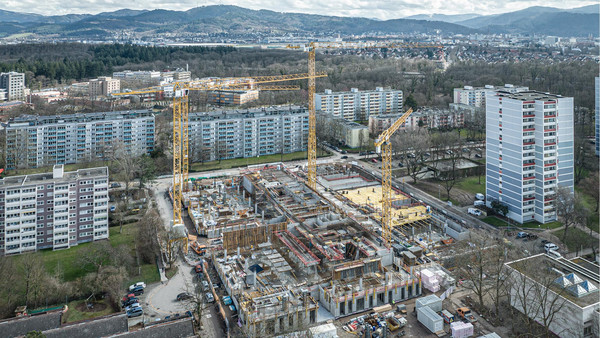
Residential Buildings
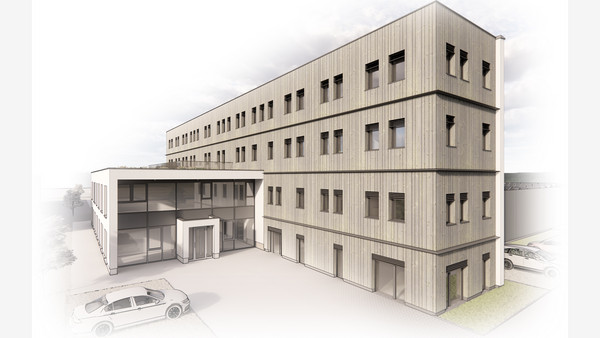
Residential Buildings
